Fundamentals of Law Assignment: Contract and Property Law Analysis
VerifiedAdded on 2021/06/17
|9
|2295
|53
Homework Assignment
AI Summary
This law assignment delves into two key areas: contract law and property law. The contract law section analyzes a scenario involving misrepresentation in an advertisement for music disks, focusing on offer, invitation to treat, and the application of cases like Carlill v Carbolic Smoke Ball Co. and Howard Marine v Ogden. It also examines the validity of an exclusion clause and the doctrine of Contra proferentem. The property law section addresses a joint tenancy issue, exploring the rights and responsibilities of joint owners, and the application of the Property Law Act 1958. It analyzes a scenario where one joint owner takes actions (mortgaging property) without the other's knowledge, and assesses the liability of both parties, referencing cases such as Frazer v Walker and Abigail v Lapin. The assignment concludes with a discussion on the responsibilities of joint owners regarding debts, and the implications of one owner's actions on the other.

Running head: FUNDAMENTALS OF LAW
Fundamentals of Law
Name of the Student
Name of the University
Author note
Fundamentals of Law
Name of the Student
Name of the University
Author note
Paraphrase This Document
Need a fresh take? Get an instant paraphrase of this document with our AI Paraphraser

1FUNDAMENTALS OF LAW
A (Contract)
Issue:
The issues that can be identified in the given scenario are:
Whether Annie is entitled to take legal action to recover the money spent by her to acquire
the disks
Whether Desert Discs have any defenses against the claims of Annie
Rule
It can be stated that in order for a promise to be regarded as an offer, the offeror must
establish that he intended to be bound by the offer as held in the case of Harvey v
Facey [1893] UKPC 1. However, it is to be mentioned that an offer is to be distinguished
from an invitation to treat. It is worth noting that subsequent to acceptance of an offer a valid
contract is formed between the parties. However, an invitation to treat cannot be accepted.
Goods on display in shops are not to be regarded as offers but mere invitation to treat as held
in the case of Fisher v Bell [1961] 1 QB 394. Advertisements are generally treated as
invitation to treat. This can be substantiated by the judgment of the Partridge v Critenden
(1968) 2 All ER 425. However, there is an exception to the aforementioned rule. In some
instances advertisements can amount to offers as established in the remarkable case of Carlill
v Carbolic Smoke Ball co [1893] 1 QB 256. In this case an advertisement had been given by
the Carbolic smokeball company that a reward of 100 pounds would be paid to anyone who
contracts influenza after using the smoke ball produced by them three times daily for two
weeks. Mrs. Carlil had purchased the smokeball and used it according to the instructions of
the advertisement. However she c contracted influenza. Thereafter she claimed the 100
pounds as per the terms of the advertisement. It was held by the court that Mrs Carlil was
A (Contract)
Issue:
The issues that can be identified in the given scenario are:
Whether Annie is entitled to take legal action to recover the money spent by her to acquire
the disks
Whether Desert Discs have any defenses against the claims of Annie
Rule
It can be stated that in order for a promise to be regarded as an offer, the offeror must
establish that he intended to be bound by the offer as held in the case of Harvey v
Facey [1893] UKPC 1. However, it is to be mentioned that an offer is to be distinguished
from an invitation to treat. It is worth noting that subsequent to acceptance of an offer a valid
contract is formed between the parties. However, an invitation to treat cannot be accepted.
Goods on display in shops are not to be regarded as offers but mere invitation to treat as held
in the case of Fisher v Bell [1961] 1 QB 394. Advertisements are generally treated as
invitation to treat. This can be substantiated by the judgment of the Partridge v Critenden
(1968) 2 All ER 425. However, there is an exception to the aforementioned rule. In some
instances advertisements can amount to offers as established in the remarkable case of Carlill
v Carbolic Smoke Ball co [1893] 1 QB 256. In this case an advertisement had been given by
the Carbolic smokeball company that a reward of 100 pounds would be paid to anyone who
contracts influenza after using the smoke ball produced by them three times daily for two
weeks. Mrs. Carlil had purchased the smokeball and used it according to the instructions of
the advertisement. However she c contracted influenza. Thereafter she claimed the 100
pounds as per the terms of the advertisement. It was held by the court that Mrs Carlil was
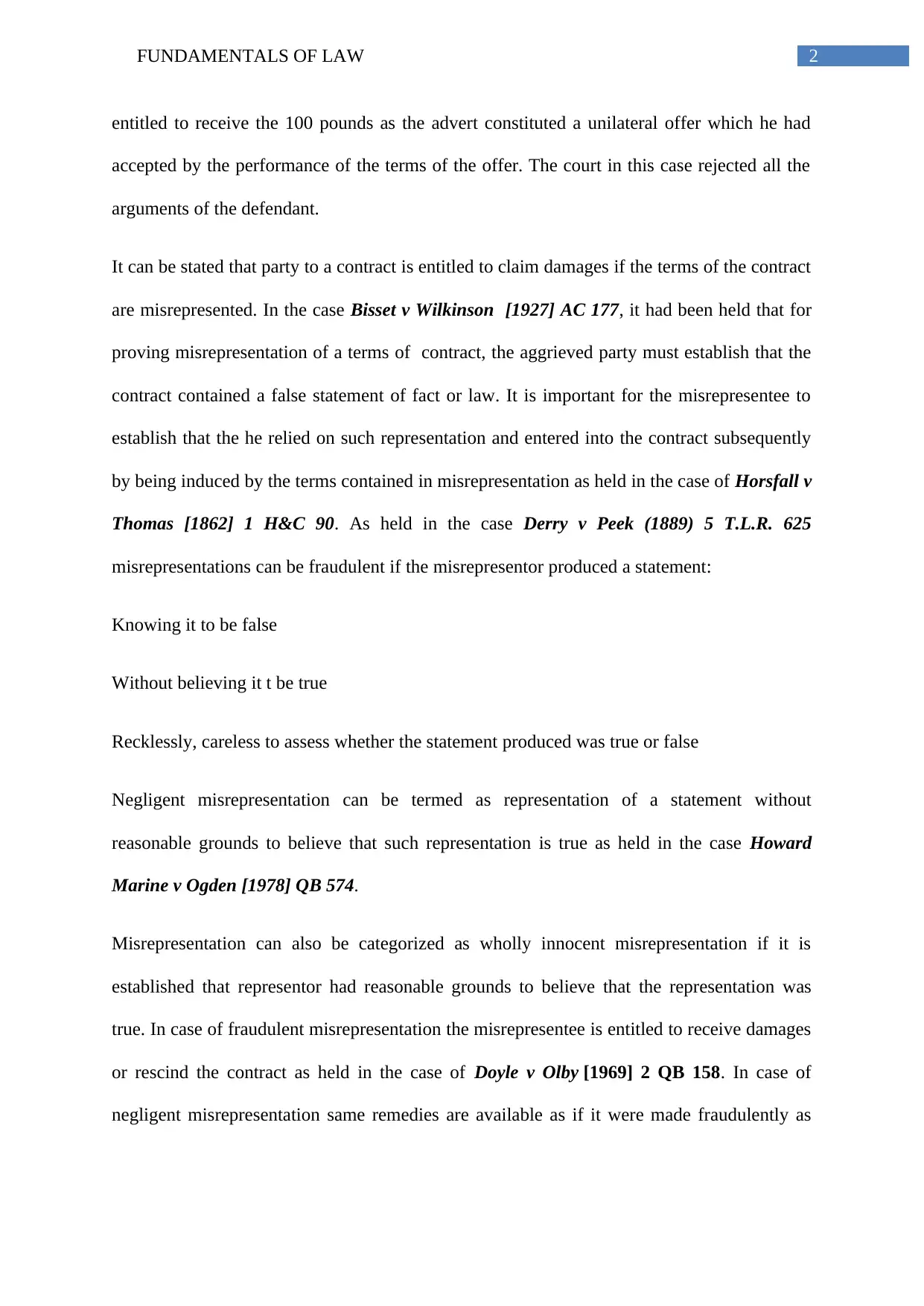
2FUNDAMENTALS OF LAW
entitled to receive the 100 pounds as the advert constituted a unilateral offer which he had
accepted by the performance of the terms of the offer. The court in this case rejected all the
arguments of the defendant.
It can be stated that party to a contract is entitled to claim damages if the terms of the contract
are misrepresented. In the case Bisset v Wilkinson [1927] AC 177, it had been held that for
proving misrepresentation of a terms of contract, the aggrieved party must establish that the
contract contained a false statement of fact or law. It is important for the misrepresentee to
establish that the he relied on such representation and entered into the contract subsequently
by being induced by the terms contained in misrepresentation as held in the case of Horsfall v
Thomas [1862] 1 H&C 90. As held in the case Derry v Peek (1889) 5 T.L.R. 625
misrepresentations can be fraudulent if the misrepresentor produced a statement:
Knowing it to be false
Without believing it t be true
Recklessly, careless to assess whether the statement produced was true or false
Negligent misrepresentation can be termed as representation of a statement without
reasonable grounds to believe that such representation is true as held in the case Howard
Marine v Ogden [1978] QB 574.
Misrepresentation can also be categorized as wholly innocent misrepresentation if it is
established that representor had reasonable grounds to believe that the representation was
true. In case of fraudulent misrepresentation the misrepresentee is entitled to receive damages
or rescind the contract as held in the case of Doyle v Olby [1969] 2 QB 158. In case of
negligent misrepresentation same remedies are available as if it were made fraudulently as
entitled to receive the 100 pounds as the advert constituted a unilateral offer which he had
accepted by the performance of the terms of the offer. The court in this case rejected all the
arguments of the defendant.
It can be stated that party to a contract is entitled to claim damages if the terms of the contract
are misrepresented. In the case Bisset v Wilkinson [1927] AC 177, it had been held that for
proving misrepresentation of a terms of contract, the aggrieved party must establish that the
contract contained a false statement of fact or law. It is important for the misrepresentee to
establish that the he relied on such representation and entered into the contract subsequently
by being induced by the terms contained in misrepresentation as held in the case of Horsfall v
Thomas [1862] 1 H&C 90. As held in the case Derry v Peek (1889) 5 T.L.R. 625
misrepresentations can be fraudulent if the misrepresentor produced a statement:
Knowing it to be false
Without believing it t be true
Recklessly, careless to assess whether the statement produced was true or false
Negligent misrepresentation can be termed as representation of a statement without
reasonable grounds to believe that such representation is true as held in the case Howard
Marine v Ogden [1978] QB 574.
Misrepresentation can also be categorized as wholly innocent misrepresentation if it is
established that representor had reasonable grounds to believe that the representation was
true. In case of fraudulent misrepresentation the misrepresentee is entitled to receive damages
or rescind the contract as held in the case of Doyle v Olby [1969] 2 QB 158. In case of
negligent misrepresentation same remedies are available as if it were made fraudulently as
⊘ This is a preview!⊘
Do you want full access?
Subscribe today to unlock all pages.

Trusted by 1+ million students worldwide

3FUNDAMENTALS OF LAW
held in the case Royscott Trust v Rogerson [1991] 2 QB 297. However, in case of innocent
misrepresentation the claimant cannot rescind the contract or claim damages.
An exclusion clause or exemption clause can be defined as a term in the contract which aims
to limit the liability of either of the parties to the contract. However, for any party to rely on
the exclusion clause it is important to bring it to the attention of the other party to the contract
as held in the case Olley v Marlborough Court [1949] 1 K.B. 532.
The doctrine of Contra proferentem is relevant in this given scenario. It can be stated that
when it comes to interpreting exclusion clauses, the courts generally interpret an ambiguity
against the person who is at fault and wishing to rely on the exclusion clause. Liability can be
restricted or excluded only if the words of the exclusion clause are precisely clear.
Application
In this given scenario, it has been provided an advertisement had been put up by the Desert
Island Disks which stated that customers are free to choose any disk of Beyonce for 2.99
dollars or choose five disks for 12.99 dollars. She relied on such offer can chose five disks of
Beyonce as per the terms of the offer. Therefore in this case it is evident that the
advertisement can be treated as an offer by the application of the Carlilv Carbolic Smoke ball
case. Annie performed the terms of the offer and subsequently a unilateral contract had been
formed. However, it was later realized by Annie that she had been charged 12.99 dollars for
each disk. In relation to the facts of the case, it can be stated that the shop had misrepresented
the terms offer which had been given through the advertisement. The misrepresentation can
be termed as negligent misrepresentation as Desert Island Disks did not make reasonable
effort to check the truth of the statements represented. Thus by the application of the Howard
Marine v Ogden case, it can be stated that Annie in this given scenario is entitled to rescind
the contract and return the disks. Further, it can be stated that the disks did not contain the
held in the case Royscott Trust v Rogerson [1991] 2 QB 297. However, in case of innocent
misrepresentation the claimant cannot rescind the contract or claim damages.
An exclusion clause or exemption clause can be defined as a term in the contract which aims
to limit the liability of either of the parties to the contract. However, for any party to rely on
the exclusion clause it is important to bring it to the attention of the other party to the contract
as held in the case Olley v Marlborough Court [1949] 1 K.B. 532.
The doctrine of Contra proferentem is relevant in this given scenario. It can be stated that
when it comes to interpreting exclusion clauses, the courts generally interpret an ambiguity
against the person who is at fault and wishing to rely on the exclusion clause. Liability can be
restricted or excluded only if the words of the exclusion clause are precisely clear.
Application
In this given scenario, it has been provided an advertisement had been put up by the Desert
Island Disks which stated that customers are free to choose any disk of Beyonce for 2.99
dollars or choose five disks for 12.99 dollars. She relied on such offer can chose five disks of
Beyonce as per the terms of the offer. Therefore in this case it is evident that the
advertisement can be treated as an offer by the application of the Carlilv Carbolic Smoke ball
case. Annie performed the terms of the offer and subsequently a unilateral contract had been
formed. However, it was later realized by Annie that she had been charged 12.99 dollars for
each disk. In relation to the facts of the case, it can be stated that the shop had misrepresented
the terms offer which had been given through the advertisement. The misrepresentation can
be termed as negligent misrepresentation as Desert Island Disks did not make reasonable
effort to check the truth of the statements represented. Thus by the application of the Howard
Marine v Ogden case, it can be stated that Annie in this given scenario is entitled to rescind
the contract and return the disks. Further, it can be stated that the disks did not contain the
Paraphrase This Document
Need a fresh take? Get an instant paraphrase of this document with our AI Paraphraser
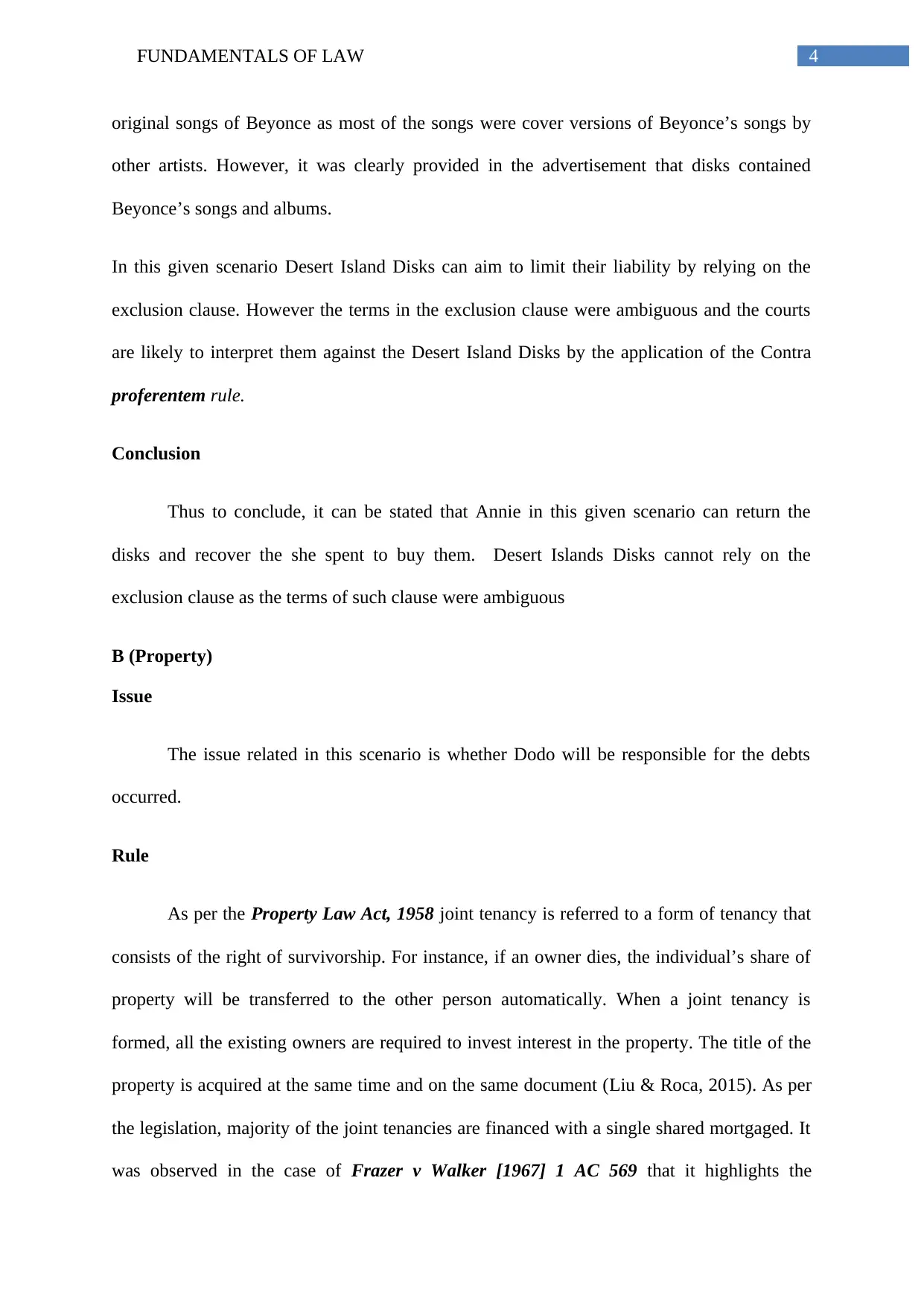
4FUNDAMENTALS OF LAW
original songs of Beyonce as most of the songs were cover versions of Beyonce’s songs by
other artists. However, it was clearly provided in the advertisement that disks contained
Beyonce’s songs and albums.
In this given scenario Desert Island Disks can aim to limit their liability by relying on the
exclusion clause. However the terms in the exclusion clause were ambiguous and the courts
are likely to interpret them against the Desert Island Disks by the application of the Contra
proferentem rule.
Conclusion
Thus to conclude, it can be stated that Annie in this given scenario can return the
disks and recover the she spent to buy them. Desert Islands Disks cannot rely on the
exclusion clause as the terms of such clause were ambiguous
B (Property)
Issue
The issue related in this scenario is whether Dodo will be responsible for the debts
occurred.
Rule
As per the Property Law Act, 1958 joint tenancy is referred to a form of tenancy that
consists of the right of survivorship. For instance, if an owner dies, the individual’s share of
property will be transferred to the other person automatically. When a joint tenancy is
formed, all the existing owners are required to invest interest in the property. The title of the
property is acquired at the same time and on the same document (Liu & Roca, 2015). As per
the legislation, majority of the joint tenancies are financed with a single shared mortgaged. It
was observed in the case of Frazer v Walker [1967] 1 AC 569 that it highlights the
original songs of Beyonce as most of the songs were cover versions of Beyonce’s songs by
other artists. However, it was clearly provided in the advertisement that disks contained
Beyonce’s songs and albums.
In this given scenario Desert Island Disks can aim to limit their liability by relying on the
exclusion clause. However the terms in the exclusion clause were ambiguous and the courts
are likely to interpret them against the Desert Island Disks by the application of the Contra
proferentem rule.
Conclusion
Thus to conclude, it can be stated that Annie in this given scenario can return the
disks and recover the she spent to buy them. Desert Islands Disks cannot rely on the
exclusion clause as the terms of such clause were ambiguous
B (Property)
Issue
The issue related in this scenario is whether Dodo will be responsible for the debts
occurred.
Rule
As per the Property Law Act, 1958 joint tenancy is referred to a form of tenancy that
consists of the right of survivorship. For instance, if an owner dies, the individual’s share of
property will be transferred to the other person automatically. When a joint tenancy is
formed, all the existing owners are required to invest interest in the property. The title of the
property is acquired at the same time and on the same document (Liu & Roca, 2015). As per
the legislation, majority of the joint tenancies are financed with a single shared mortgaged. It
was observed in the case of Frazer v Walker [1967] 1 AC 569 that it highlights the
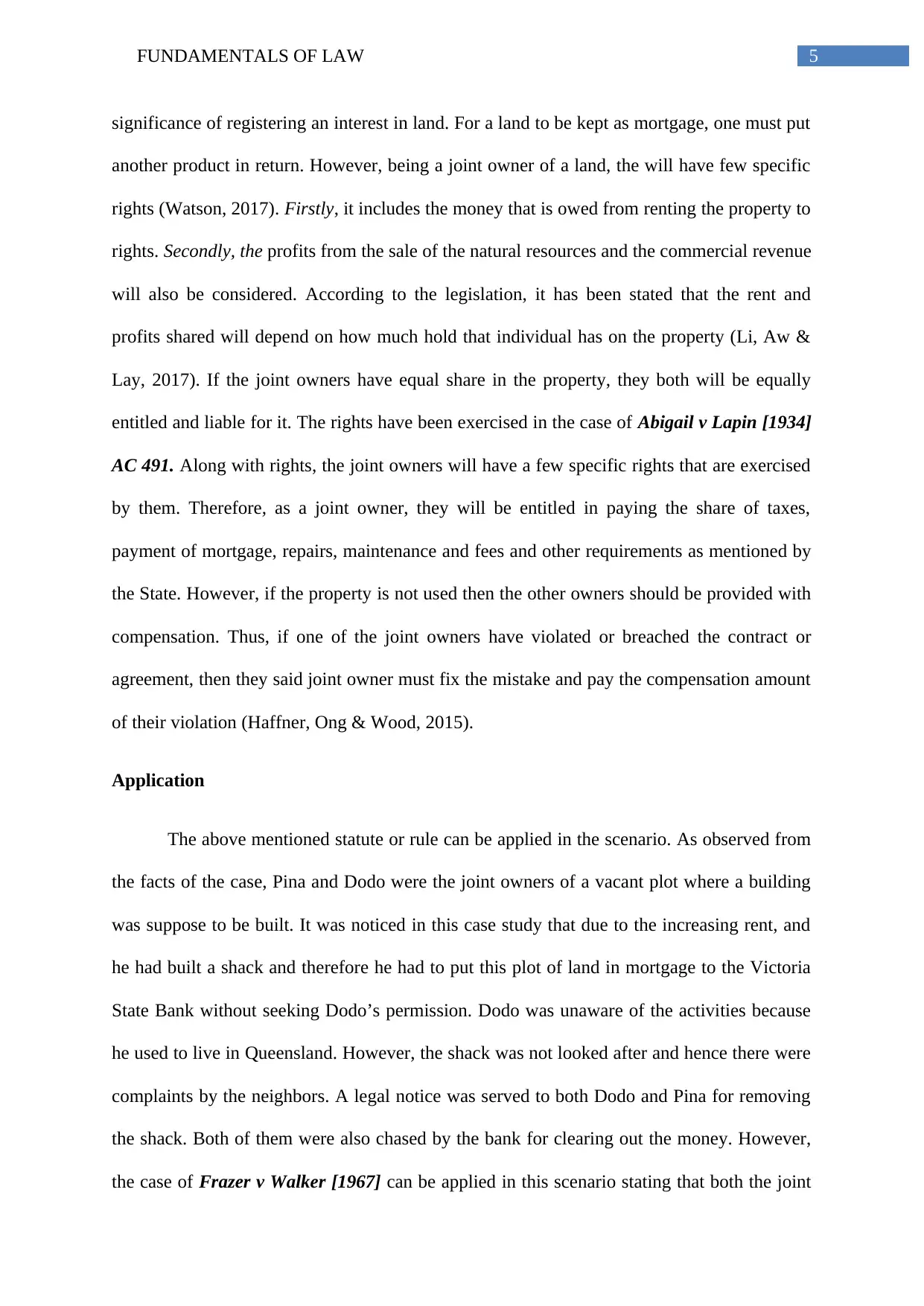
5FUNDAMENTALS OF LAW
significance of registering an interest in land. For a land to be kept as mortgage, one must put
another product in return. However, being a joint owner of a land, the will have few specific
rights (Watson, 2017). Firstly, it includes the money that is owed from renting the property to
rights. Secondly, the profits from the sale of the natural resources and the commercial revenue
will also be considered. According to the legislation, it has been stated that the rent and
profits shared will depend on how much hold that individual has on the property (Li, Aw &
Lay, 2017). If the joint owners have equal share in the property, they both will be equally
entitled and liable for it. The rights have been exercised in the case of Abigail v Lapin [1934]
AC 491. Along with rights, the joint owners will have a few specific rights that are exercised
by them. Therefore, as a joint owner, they will be entitled in paying the share of taxes,
payment of mortgage, repairs, maintenance and fees and other requirements as mentioned by
the State. However, if the property is not used then the other owners should be provided with
compensation. Thus, if one of the joint owners have violated or breached the contract or
agreement, then they said joint owner must fix the mistake and pay the compensation amount
of their violation (Haffner, Ong & Wood, 2015).
Application
The above mentioned statute or rule can be applied in the scenario. As observed from
the facts of the case, Pina and Dodo were the joint owners of a vacant plot where a building
was suppose to be built. It was noticed in this case study that due to the increasing rent, and
he had built a shack and therefore he had to put this plot of land in mortgage to the Victoria
State Bank without seeking Dodo’s permission. Dodo was unaware of the activities because
he used to live in Queensland. However, the shack was not looked after and hence there were
complaints by the neighbors. A legal notice was served to both Dodo and Pina for removing
the shack. Both of them were also chased by the bank for clearing out the money. However,
the case of Frazer v Walker [1967] can be applied in this scenario stating that both the joint
significance of registering an interest in land. For a land to be kept as mortgage, one must put
another product in return. However, being a joint owner of a land, the will have few specific
rights (Watson, 2017). Firstly, it includes the money that is owed from renting the property to
rights. Secondly, the profits from the sale of the natural resources and the commercial revenue
will also be considered. According to the legislation, it has been stated that the rent and
profits shared will depend on how much hold that individual has on the property (Li, Aw &
Lay, 2017). If the joint owners have equal share in the property, they both will be equally
entitled and liable for it. The rights have been exercised in the case of Abigail v Lapin [1934]
AC 491. Along with rights, the joint owners will have a few specific rights that are exercised
by them. Therefore, as a joint owner, they will be entitled in paying the share of taxes,
payment of mortgage, repairs, maintenance and fees and other requirements as mentioned by
the State. However, if the property is not used then the other owners should be provided with
compensation. Thus, if one of the joint owners have violated or breached the contract or
agreement, then they said joint owner must fix the mistake and pay the compensation amount
of their violation (Haffner, Ong & Wood, 2015).
Application
The above mentioned statute or rule can be applied in the scenario. As observed from
the facts of the case, Pina and Dodo were the joint owners of a vacant plot where a building
was suppose to be built. It was noticed in this case study that due to the increasing rent, and
he had built a shack and therefore he had to put this plot of land in mortgage to the Victoria
State Bank without seeking Dodo’s permission. Dodo was unaware of the activities because
he used to live in Queensland. However, the shack was not looked after and hence there were
complaints by the neighbors. A legal notice was served to both Dodo and Pina for removing
the shack. Both of them were also chased by the bank for clearing out the money. However,
the case of Frazer v Walker [1967] can be applied in this scenario stating that both the joint
⊘ This is a preview!⊘
Do you want full access?
Subscribe today to unlock all pages.

Trusted by 1+ million students worldwide

6FUNDAMENTALS OF LAW
owners have a specific rights and duties that needs to be exercised. Dodo being one of the
joint owners did not have the knowledge of the activities or decisions that Pina had taken.
However, as per the statute, Dodo will be liable and responsible for these debts as per the
legislation. This has been proved in the case above mentioned. Since both of them were joint
owners therefore, they will be entitled to equal amount of profits and losses of the land.
Although, he was not involved or informed regarding the mortgage but he will be responsible
for clearing the debts that he owes to the Bank. However, Pina should be the one responsible
for the debts but since both Dodo and Pina were joint owners, Dodo will be responsible for
the debts equally as per the statute.
Conclusion
It can be concluded stating that Dodo will be held responsible for these debts since he
was the joint owner for that plot of land along with Pina.
owners have a specific rights and duties that needs to be exercised. Dodo being one of the
joint owners did not have the knowledge of the activities or decisions that Pina had taken.
However, as per the statute, Dodo will be liable and responsible for these debts as per the
legislation. This has been proved in the case above mentioned. Since both of them were joint
owners therefore, they will be entitled to equal amount of profits and losses of the land.
Although, he was not involved or informed regarding the mortgage but he will be responsible
for clearing the debts that he owes to the Bank. However, Pina should be the one responsible
for the debts but since both Dodo and Pina were joint owners, Dodo will be responsible for
the debts equally as per the statute.
Conclusion
It can be concluded stating that Dodo will be held responsible for these debts since he
was the joint owner for that plot of land along with Pina.
Paraphrase This Document
Need a fresh take? Get an instant paraphrase of this document with our AI Paraphraser
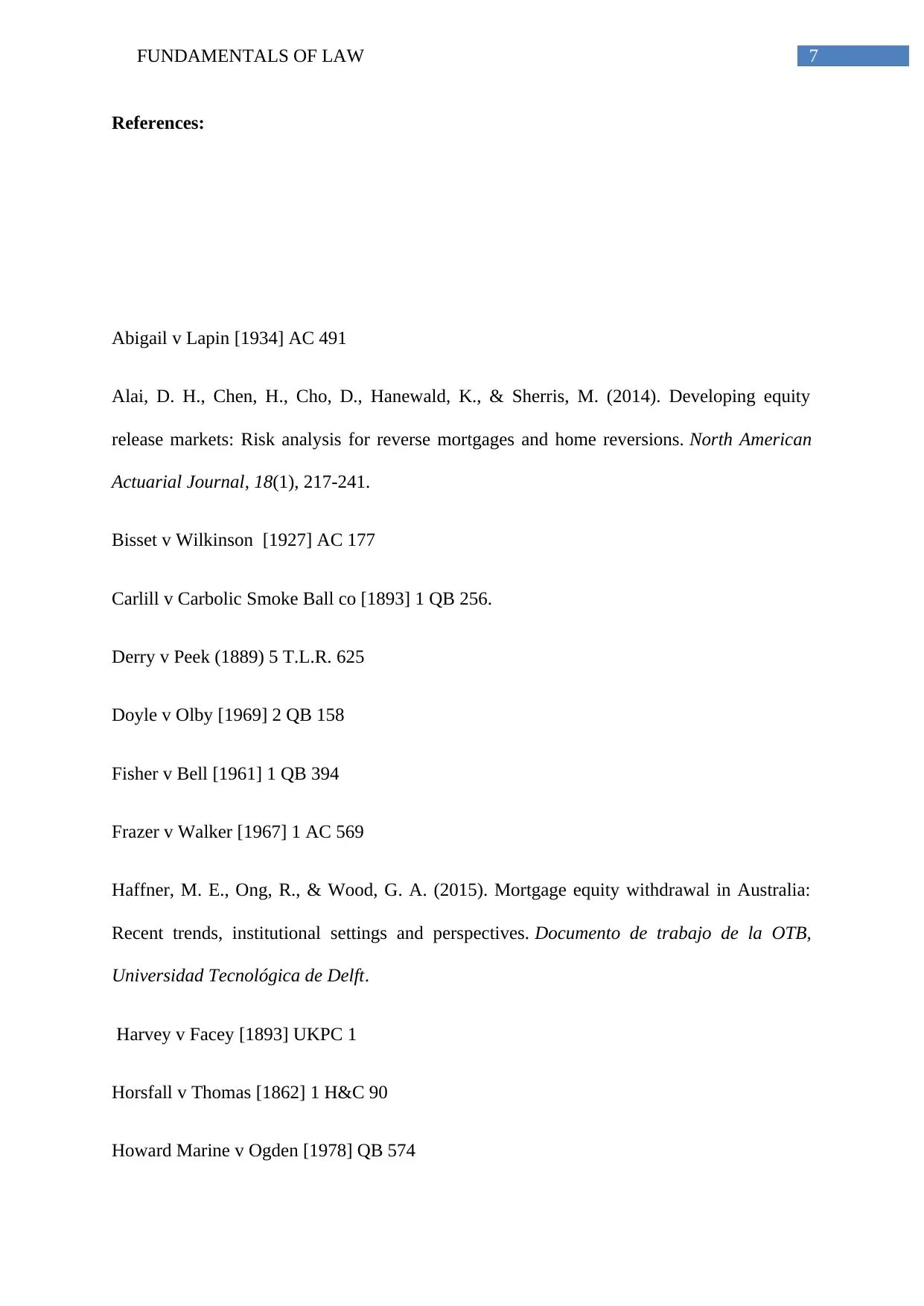
7FUNDAMENTALS OF LAW
References:
Abigail v Lapin [1934] AC 491
Alai, D. H., Chen, H., Cho, D., Hanewald, K., & Sherris, M. (2014). Developing equity
release markets: Risk analysis for reverse mortgages and home reversions. North American
Actuarial Journal, 18(1), 217-241.
Bisset v Wilkinson [1927] AC 177
Carlill v Carbolic Smoke Ball co [1893] 1 QB 256.
Derry v Peek (1889) 5 T.L.R. 625
Doyle v Olby [1969] 2 QB 158
Fisher v Bell [1961] 1 QB 394
Frazer v Walker [1967] 1 AC 569
Haffner, M. E., Ong, R., & Wood, G. A. (2015). Mortgage equity withdrawal in Australia:
Recent trends, institutional settings and perspectives. Documento de trabajo de la OTB,
Universidad Tecnológica de Delft.
Harvey v Facey [1893] UKPC 1
Horsfall v Thomas [1862] 1 H&C 90
Howard Marine v Ogden [1978] QB 574
References:
Abigail v Lapin [1934] AC 491
Alai, D. H., Chen, H., Cho, D., Hanewald, K., & Sherris, M. (2014). Developing equity
release markets: Risk analysis for reverse mortgages and home reversions. North American
Actuarial Journal, 18(1), 217-241.
Bisset v Wilkinson [1927] AC 177
Carlill v Carbolic Smoke Ball co [1893] 1 QB 256.
Derry v Peek (1889) 5 T.L.R. 625
Doyle v Olby [1969] 2 QB 158
Fisher v Bell [1961] 1 QB 394
Frazer v Walker [1967] 1 AC 569
Haffner, M. E., Ong, R., & Wood, G. A. (2015). Mortgage equity withdrawal in Australia:
Recent trends, institutional settings and perspectives. Documento de trabajo de la OTB,
Universidad Tecnológica de Delft.
Harvey v Facey [1893] UKPC 1
Horsfall v Thomas [1862] 1 H&C 90
Howard Marine v Ogden [1978] QB 574
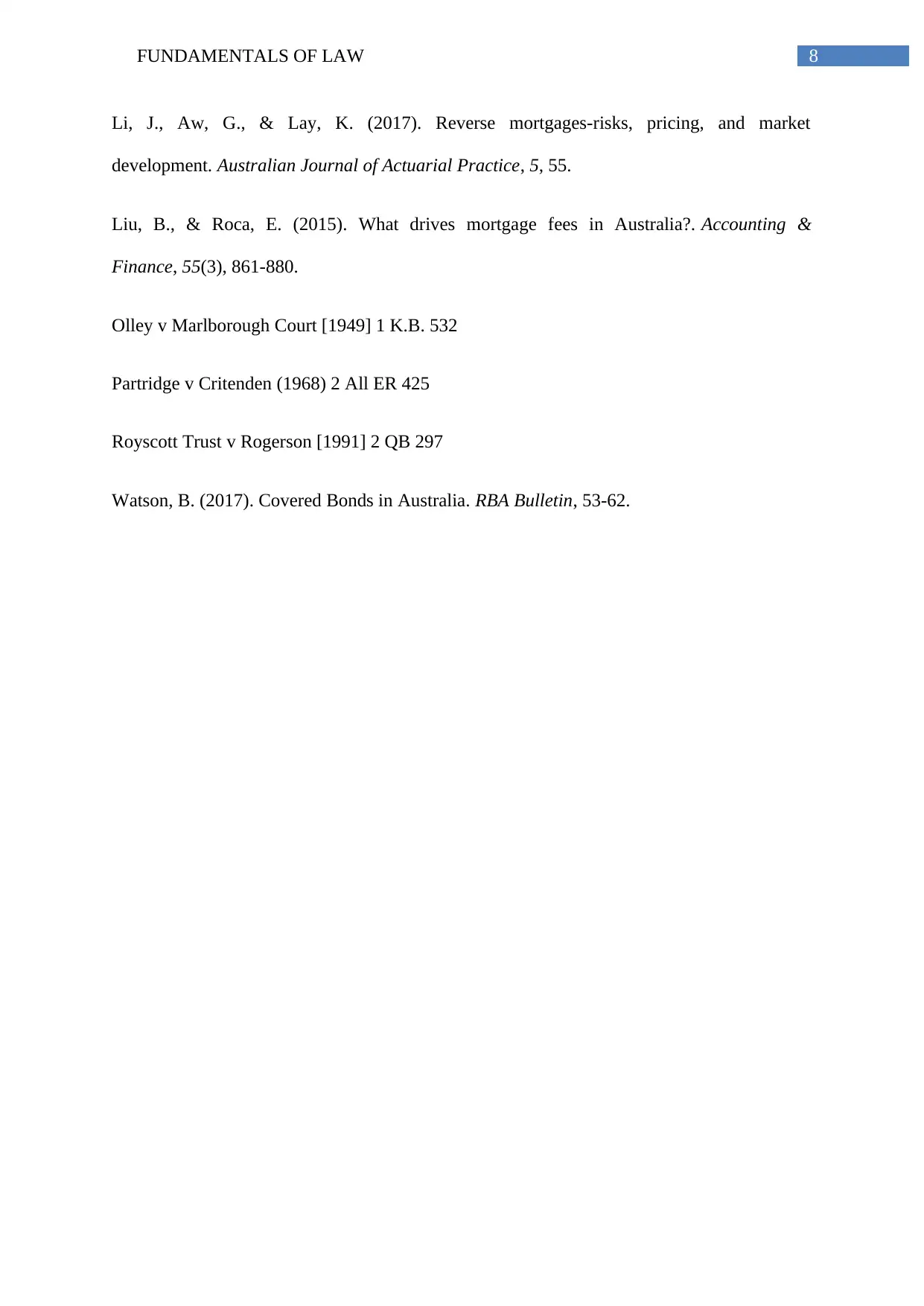
8FUNDAMENTALS OF LAW
Li, J., Aw, G., & Lay, K. (2017). Reverse mortgages-risks, pricing, and market
development. Australian Journal of Actuarial Practice, 5, 55.
Liu, B., & Roca, E. (2015). What drives mortgage fees in Australia?. Accounting &
Finance, 55(3), 861-880.
Olley v Marlborough Court [1949] 1 K.B. 532
Partridge v Critenden (1968) 2 All ER 425
Royscott Trust v Rogerson [1991] 2 QB 297
Watson, B. (2017). Covered Bonds in Australia. RBA Bulletin, 53-62.
Li, J., Aw, G., & Lay, K. (2017). Reverse mortgages-risks, pricing, and market
development. Australian Journal of Actuarial Practice, 5, 55.
Liu, B., & Roca, E. (2015). What drives mortgage fees in Australia?. Accounting &
Finance, 55(3), 861-880.
Olley v Marlborough Court [1949] 1 K.B. 532
Partridge v Critenden (1968) 2 All ER 425
Royscott Trust v Rogerson [1991] 2 QB 297
Watson, B. (2017). Covered Bonds in Australia. RBA Bulletin, 53-62.
⊘ This is a preview!⊘
Do you want full access?
Subscribe today to unlock all pages.

Trusted by 1+ million students worldwide
1 out of 9
Related Documents
Your All-in-One AI-Powered Toolkit for Academic Success.
+13062052269
info@desklib.com
Available 24*7 on WhatsApp / Email
![[object Object]](/_next/static/media/star-bottom.7253800d.svg)
Unlock your academic potential
Copyright © 2020–2025 A2Z Services. All Rights Reserved. Developed and managed by ZUCOL.




